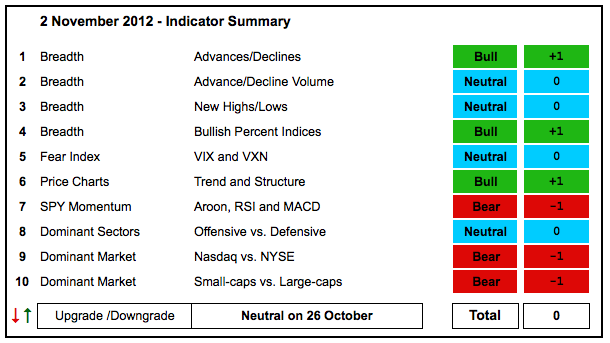The indicator summary remains neutral. Weakness in the Nasdaq weighed on the Nasdaq AD Volume Line and the technology sector, both of which are bearish. Strength in the finance sector kept the NYSE AD Line strong and NYSE Net New Highs remain positive. I am also starting to see relative strength in small-caps and mid-caps the last two weeks, which could bode well for the market. There were big surges on Thursday and follow through breakouts would be bullish. Let's see how the market reacts to the employment report and election.
- AD Lines: Bullish. The Nasdaq AD Line got a bounce where it needed to bounce. A break below the October low would reverse the uptrend that has been in place since early June. The NYSE AD Line hit a new high in mid October and established first support with the late September low.
- AD Volume Lines: Neutral. The Nasdaq AD Volume Line formed a large bearish divergence with the September peak and broke support in October. The NYSE AD Volume Line remains in an uptrend since early June and the late August low marks key support.
- Net New Highs: Neutral. Nasdaq Net New Highs dipped into negative territory twice in October and the cumulative line now equals the 10-day EMA. NYSE Net New Highs remain positive and the cumulative line has yet to break its 10-day EMA.
- Bullish Percent Indices: Bullish. All nine sector BPIs remain above 50%. The Technology Bullish% Index ($BPINFO) is the "least strong" with a 50.63% reading.
- VIX/VXN: Neutral. The Nasdaq 100 Volatility Index ($VXN) broke above its early September high last week, but the S&P 500 Volatility Index ($VIX) hit resistance from this high. Both fell back the last few days for a split decision. $VXN is considered bearish, but $VIX remains bullish.
- Trend-Structure: Bullish. DIA, IWM, MDY, QQQ and SPY recorded 52-week highs in September and then moved into corrective mode. IWM and QQQ are in six week downtrends. SPY and DIA broke their September lows, but are still less than 5% below their September peaks.
- SPY Momentum: Bearish. RSI broke below 40 last week. MACD(5,35,5) turned negative and moved to its lowest level since mid June. Aroon turned bearish with a move below -50 on October 12 and again this week.
- Offensive Sector Performance: Neutral. It is the same old story. Relative weakness in XLK is offset by relative strength in XLF. XLI and XLY are still performing in line.
- Nasdaq Performance: Bearish. The $COMPQ:$NYA ratio peaked in early September and broke down in October. The Nasdaq shows some serious relative weakness.
- Small-cap Performance: Bearish. A higher low formed in October and the $RUT:$OEX ratio perked up the last two weeks. The early signs of a trend reversal are appearing, but I am not quite ready to turn bullish on this indicator.
- Breadth Charts (here) and Inter-market charts (here) have been updated.

This table is designed to offer an objective look at current market conditions. It does not aim to pick tops or bottoms. Instead, it seeks to identify noticeable shifts in buying and selling pressure. With 10 indicator groups, the medium-term evidence is unlikely to change drastically overnight.
Previous turns include:
Neutral on 26-October-12
Positive on 6-July-12
Negative on 18-May-12
Positive on 30-December-11
Negative on 16-December-11
Positive on 3-December-11
Negative on 23-November-11
Positive on 28-October-11
Negative on 5-August-11
Neutral on 29-Jul-11
Positive on 30-Jun-11
Negative on 17-Jun-11
Positive on 25-Mar-11
Negative on 18-Mar-11
Positive on 3-Sep-10
Negative on 13-Aug-10
Positive on 6-Aug-10
Negative on 24-Jun-10
Positive on 18-Jun-10
Negative on 11-Jun-10
Positive on 5-March-10
Negative on 5-Feb-10
Positive on 11-Sept-09

About the author:
Arthur Hill, CMT, is the Chief Technical Strategist at TrendInvestorPro.com. Focusing predominantly on US equities and ETFs, his systematic approach of identifying trend, finding signals within the trend, and setting key price levels has made him an esteemed market technician. Arthur has written articles for numerous financial publications including Barrons and Stocks & Commodities Magazine. In addition to his Chartered Market Technician (CMT) designation, he holds an MBA from the Cass Business School at City University in London.
Learn More






